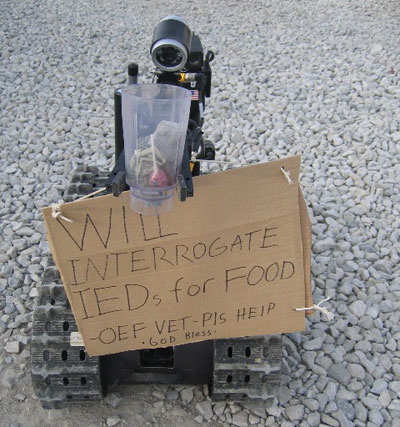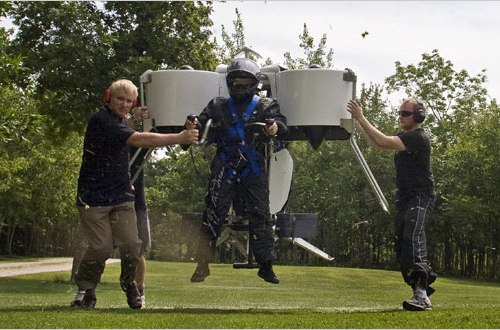
Martin Aircraft, the ducted fan “jetpack” people, have announced that the Civil Air Authority of New Zealand, is now allowing manned test flights of their “jetpack”, but only if they stay below 6 meters (~20 feet), and remain in uninhabited areas.

Martin Aircraft, the ducted fan “jetpack” people, have announced that the Civil Air Authority of New Zealand, is now allowing manned test flights of their “jetpack”, but only if they stay below 6 meters (~20 feet), and remain in uninhabited areas.

Dr. Mark Post‘s lab at Maastricht University has created meat in a vat. The press is calling it “hamburger,” so I guess it is cloned bovine muscle. In a 2009 Wired interview, Post said that the problems facing in vitro meat is creating the texture. Taste is of little concern because, “The food industry is already expert at enhancing taste.”

According to Lt. Col. Dave Thompson, USMC commander of cybernetic warriors, or chief robot wrangler, there are over 2000 military bots in Afghanistan. Doing the math, this means about one out of fifty soldiers are robots. It needs to be said, that this number is only the number of bots deployed, not the number that are actually utilized.
Also, Thompson was only counting land bots, not the aerial drones that get all the headlines, and movies. These bots are the bomb defusing Talons, PackBots, and few other mine clearing bots. Notably missing from Afghanistan are SWORDS, Talons fitted with M-60s and other goodies. Those were withdrawn from the battlefield after they went berzerk during their deployment in Iraq. (“Kill-bots want peace too; but programs must complete.”) Also missing from this list are the more advanced bots, such as self driving cars, and of course everyone’s favorite BigDog.

The Martin jetpack Lisa mentioned, is undergoing final testing . Estimated retail price: $100,000.
Part of me would like a jet pack, but in all honesty, I don’t know what I’d do with it. I guess commute with it. Of course, if I did that, I’d feel like I was underdressed for the jet pack crowd if I wasn’t wearing a tux. Jet packs aren’t Buck Rodgers, as much as James Bond for me. If I had one, I’d want to walk out of a cocktail party, followed close behind by an overweight archnemesis and his sultry girlfriend. I’d turn and say, “Be seeing you,” snap the visor shut on my helmet and blast away straight up into the night, while the archnemesis turns red in frustration, and the girlfriend clutches her bosom and looks up longingly as the jet wash waves her hair and dress, making her look ever more ravishingly beautiful.
In reality though, the jet pack would be sitting out in my apartment’s parking lot under a tree than constantly drops leaves and pollen on it, so I’d have pull a big tarp off of it. Drag it out into the middle of the lot. Put on a helmet that would be too tight. Fumble with a five-point harness. Then, fly to Mountain View. Land in another parking lot, where I’d have to ever so carefully fly/drag it to a post that I could chain it to with a bike lock. Repeat the process at the end of the day, only to find a noise pollution notice from the HOA taped to my apartment door.

Wow. No this is big. As Richard Ebright, molecular biologist at Rutgers, said, “This is literally a turning point in the relationship between man and nature. ”
Scientists at the J. Craig Venter Institute, created a synthetic DNA strand, implanted it into a gutted bacterium, and got it under go mitosis. The press is billing this as “synthetic life,” but it’s not. Not yet. You still need a natural cell. How long it will take to create the first fully synthetic organism I don’t know. I’m sure someone is working on it though.
According to NPR, the hard part of creating the synthetic DNA was making it long enough. Previous technology could only stitch together a few hundred base pairs, while a viable DNA sequence needs millions. The trick was to build small fragments and then place the fragments into yeast to do the final assembly.
So that they could prove that the synthetic DNA duplicated correctly, the team added a set of watermarks to the end of the DNA strand. The watermarks were the names of everyone on the 46 person team, along with the James Joyce quote, “to live, to err, to fall, to triumph, to recreate life out of life.” Since each base pair encodes two bits (One bit for the nucleobases (adenine-thymine versus cytosine-guanine), and the second for the orientation (AT/CG versus TA/GC).), and assuming the text was encoded using the 26 letters of the English alphabet, you would need three base pairs per character. Since 2^(2*3) = 2^6 = 64, you would have 41 empty encodings. This means you could encode letters, digits, and punctuation. For comparison, after removing all the control codes and lowercase letters, ASCII contains 69 characters.
I find this fascinating on two levels. First, Venter uses the words like “software” and “programming” describe this work. DNA is software, but it’s not just operating instructions, it’s building instructions. Today, we already have scientists that grab single genes from other species and splice them into other organisms, like Roundup resistant soybeans. If we can build entire DNA sequences, this implies a future organisms could be uploaded to a Thingiverse-like site, where users could download organisms. Also, if the genes and the proteome can be understood (or at least understood on a block level), it seems possible that scientists could begin to construct single cell organisms by assembling a mixture of parts, like a Lego kit.
The other thing that’s interesting are these watermarks. I love the idea of encoding messages into DNA sequences. It’s microfilm for the 21st century. One could build an entire design fiction story around this idea. You could store a message inside a person, like Leeloo, or use it in a bacteria dead drop. Of course, over time your message would be corrupted. Which makes me wonder how mutations manifest? Does the strand break and the reform incorrectly, meaning splices and flips, or what? If so what types of error correction would be needed? Simple parity checks wouldn’t work for this.
We do live in the future.
The Astonishing Tribe (TAT), using software from Polar Rose, has created a mobile application that uses facial recognition to perform social search. Users submit photos of their faces to the Recognizr website, along with what web links they want associated with them (e.g. blogs, Flickr, or YouTube). Then by downloading an app to their mobile phone, they can take a photo of a stranger, submit it to the website, and if that stranger is a Recognizr user, find out all about him/her.
This work reminds me of Bradley Rhodes‘s old wearable/AR emacs plugin, the Remembrance Agent. The idea behind that application was that, while wearing a PC-104 based Lizzy wearable computer, you’d type in names into emacs, and then bring up whatever notes you had about them. I don’t remember if it integrated with the Insidious Big Brother Database or not.